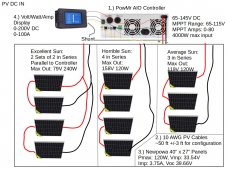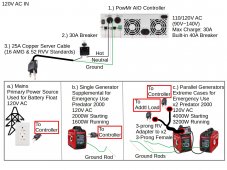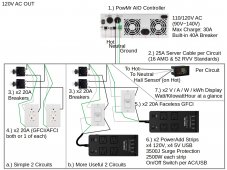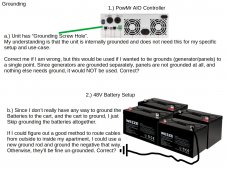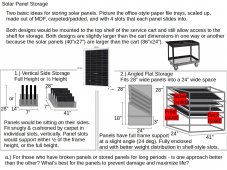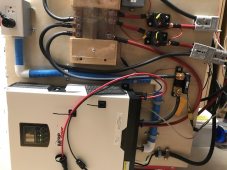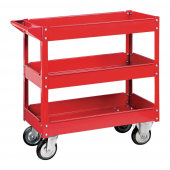I’m about to build a hand-cart variation of the typical tiny house/jobsite trailer power stations. Looking for input from some of you seasoned pros first. #1 priority is fire and electrocution safety.
PURPOSE:
I live in Florida, and we have lost power for days or weeks at a time due to weather such as hurricanes and tornadoes. I’m basically aiming for the output and capabilities of a permanent house setup, for my large APARTMENT, where nothing can be permanent. Every option I’ve seen that could work is tens of thousands more than I want to spend. So, one day, I put a little too much sugar in my coffee, and next thing I know, there’s a few thousand dollars worth of stuff showing up at my door with the grand idea that I would MAKE what I needed, on a budget.
That’s where we are. I have the bulk of the stuff, but want your input on wiring and some of the components before I put it all together and apply power for the first time.
We need to be able to power 2 mid-size refrigerators, an standalone single-room A/C unit, box fans, lights, and the occasional cooking appliance (even a 1000W microwave). Ideally all at one time, without having to juggle plugged-in devices to manage the load. Est 300W low, 500-1000W avg, peaks upwards of 2500W or more. ...and we want some overhead to be able to grow and use more than that if needed. It’s an emergency power station to be able to live very comfortably for the days or weeks we don’t have power. It’s not just comfort. It’s also for health reasons such as powering healthcare devices, having a climate-controlled room, and keeping medicine cold. It’s also intended to be portable so that basically everything is self-contained, and we wheel it out when it’s needed and roll it out of the way when not needed. It’s closer to what many of you are doing with mobile job-site trailers and off-grid tiny houses than the other 2 or 3 much smaller cart projects I’ve seen on here.
BASIC DESIGN:
Back in the late 90’s and early 2000’s, I installed mobile electronics in vehicles as a profession. I’m going to treat this thing like it was custom RV panels being made using MDF and carpet, just like I would have back then. All components will be mounted to the MDF boards, and the boards will be mounted into/onto the service cart.
The cart will not only house the heavy batteries and all of the electronic components, but also have protective storage built-in for the solar panels when they’re not being used, and have storage for all the wires/adapters/accessories for this mobile emergency power station.
Generators will be stored separately outside, but other than that, it’s intended to be EVERYTHING, all-in-one, safe, with secure hard-mounted components, and portable, so there’s very little down-time and zero fuss pulling it out and setting it up when those emergencies arise.

MAIN COMPONENTS:
1.) PowMr (generic) All-in-one Charger/Inverter 120VAC In/Out, 80A MPPT Charger, 3500W Inverter, 48VDC
https://www.amazon.com/gp/product/B08HYHSD8G
2.) x4 Weize 12V 100Ah Deep Cycle AGM SLA VRLA Batteries (in series, 48V)
https://www.amazon.com/gp/product/B07SW353M8
3.) x4 Newpowa 120W 24V Solar Panels (Pmax: 120W, Vmp: 34.0V, Imp: 3.52A)
https://www.amazon.com/gp/product/B07H4HS7QM
4.) x2 Predator 2000 Generators (1600W continuous) with parallel kit (3200W continuous)
https://www.harborfreight.com/2000-watt-super-quiet-inverter-generator-62523.html
5.) Harbor Freight 450 lb capacity 24”x36” Service Cart
https://www.harborfreight.com/24-in-x-36-in-two-shelf-steel-service-cart-62587.html
It will be so much easier and clearer if I just share my tentative diagrams...and even easier if I break it down per-system. So here we go (many more posts coming).
PURPOSE:
I live in Florida, and we have lost power for days or weeks at a time due to weather such as hurricanes and tornadoes. I’m basically aiming for the output and capabilities of a permanent house setup, for my large APARTMENT, where nothing can be permanent. Every option I’ve seen that could work is tens of thousands more than I want to spend. So, one day, I put a little too much sugar in my coffee, and next thing I know, there’s a few thousand dollars worth of stuff showing up at my door with the grand idea that I would MAKE what I needed, on a budget.
That’s where we are. I have the bulk of the stuff, but want your input on wiring and some of the components before I put it all together and apply power for the first time.
We need to be able to power 2 mid-size refrigerators, an standalone single-room A/C unit, box fans, lights, and the occasional cooking appliance (even a 1000W microwave). Ideally all at one time, without having to juggle plugged-in devices to manage the load. Est 300W low, 500-1000W avg, peaks upwards of 2500W or more. ...and we want some overhead to be able to grow and use more than that if needed. It’s an emergency power station to be able to live very comfortably for the days or weeks we don’t have power. It’s not just comfort. It’s also for health reasons such as powering healthcare devices, having a climate-controlled room, and keeping medicine cold. It’s also intended to be portable so that basically everything is self-contained, and we wheel it out when it’s needed and roll it out of the way when not needed. It’s closer to what many of you are doing with mobile job-site trailers and off-grid tiny houses than the other 2 or 3 much smaller cart projects I’ve seen on here.
BASIC DESIGN:
Back in the late 90’s and early 2000’s, I installed mobile electronics in vehicles as a profession. I’m going to treat this thing like it was custom RV panels being made using MDF and carpet, just like I would have back then. All components will be mounted to the MDF boards, and the boards will be mounted into/onto the service cart.
The cart will not only house the heavy batteries and all of the electronic components, but also have protective storage built-in for the solar panels when they’re not being used, and have storage for all the wires/adapters/accessories for this mobile emergency power station.
Generators will be stored separately outside, but other than that, it’s intended to be EVERYTHING, all-in-one, safe, with secure hard-mounted components, and portable, so there’s very little down-time and zero fuss pulling it out and setting it up when those emergencies arise.

MAIN COMPONENTS:
1.) PowMr (generic) All-in-one Charger/Inverter 120VAC In/Out, 80A MPPT Charger, 3500W Inverter, 48VDC
https://www.amazon.com/gp/product/B08HYHSD8G
2.) x4 Weize 12V 100Ah Deep Cycle AGM SLA VRLA Batteries (in series, 48V)
https://www.amazon.com/gp/product/B07SW353M8
3.) x4 Newpowa 120W 24V Solar Panels (Pmax: 120W, Vmp: 34.0V, Imp: 3.52A)
https://www.amazon.com/gp/product/B07H4HS7QM
4.) x2 Predator 2000 Generators (1600W continuous) with parallel kit (3200W continuous)
https://www.harborfreight.com/2000-watt-super-quiet-inverter-generator-62523.html
5.) Harbor Freight 450 lb capacity 24”x36” Service Cart
https://www.harborfreight.com/24-in-x-36-in-two-shelf-steel-service-cart-62587.html
It will be so much easier and clearer if I just share my tentative diagrams...and even easier if I break it down per-system. So here we go (many more posts coming).




